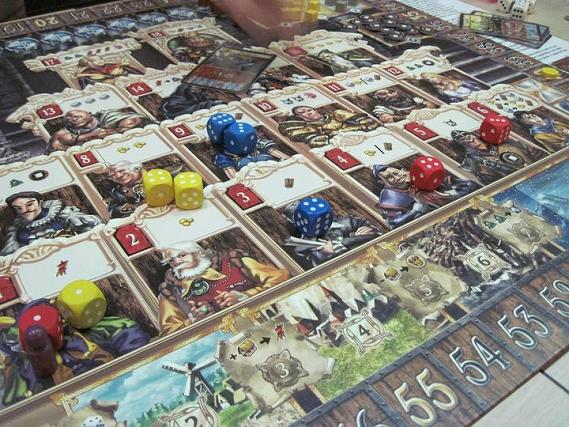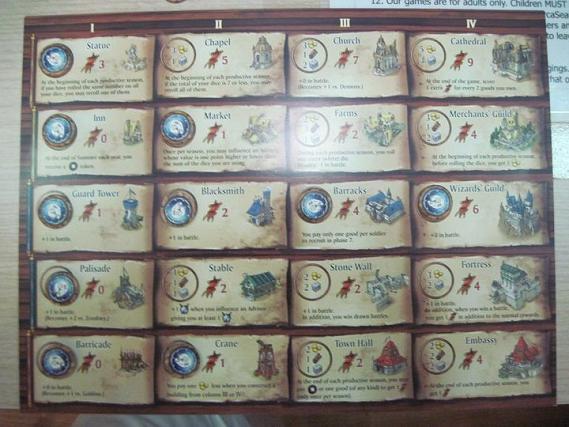23 Jul

The board depicts the various advisers available using a colorful and cartoony art style which I find quite appealing.
Kingsburg was a game that we’ve seen others playing at CarcaSean several times previously, but we only played it ourselves recently. It’s a dice-based game that’s surprisingly and pleasantly low on luck factor. It’s very easy to learn so I’ll just go my bullet-point format for this one.
- You roll all of the dice you have and then decide where to put them, making it feel very similar to a worker placement game. Since you normally have three dice, you can split them up and put them in three different spots (unlikely, since you’d have to get a different result on each die and you’d be in competition with the other players for the spaces) or add two or three together to place in a spot. Due to all of the possible combinations, there are quite a few choices of where to put your dice on.
- There’s also a chit that lets you add +2 to any dice roll and you may get an extra die sometimes due to having a building or because you’re the player with the fewest buildings, adding even more possible combinations. Since each space can only have one die on it, you need to strategically place your dice in an order that will shut out your opponents and preempt them from shutting you out. This can result in a certain amount of analysis paralysis.
- It’s quite cool that even low dice rolls aren’t necessarily bad results. It’s possible to get a resource for a single die, even you rolled relatively badly. Of course, it’s always exciting to see the ultra-high results but that’s not how the game is won. I’m more dubious about the rule that gives the player the most buildings an extra Victory Point every turn. Won’t that just make it harder for the other players to catch up? Of course, there are other catch up mechanics to balance it out as well.
- Supposedly the different building tracks, approximating tech trees found in other games, provide different paths to win the game, but I couldn’t really discern different strategies from my one play. It looks like each player ends up building all of the early stages of each track anyway and specialization only happens at the top ends of the tracks. I mostly built what I could based on what resources I could get instead of having any clear determination about what to go for. But then I didn’t do very well in our game anyway.
- The battles at the end of each year seem a bit too easy to me. Except for the final year, no one bothered to buy any soldiers or influence any of the military advisers at all. I hear that the expansion changes this and makes it more important to invest resources early on to be safe. I do like how all the players share a single die roll and so feel compelled to maintain their military strength at a level fairly close to each other.
- Overall, this is another excellent game that falls more on the lighter end of the spectrum. It would be interesting to play this with more players. I’d imagine that the competition would be a lot more cut-throat and having players end up with wasted dice would be a regular occurrence.

The mat on which you record the buildings you’ve constructed.
Written on July 23 2010 and is filed under Boardgames.
You can follow any responses to this entry through the RSS 2.0 feed.
You can leave a response, or trackback from your own site.
Leave a Reply